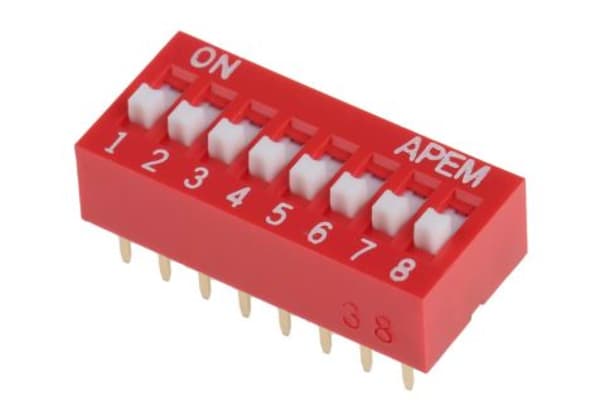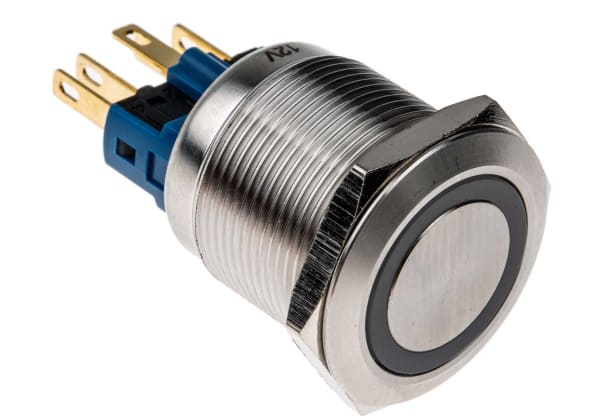- Published 1 Feb 2023
- Last Modified 29 Aug 2023
- 11 min
A Complete Guide to Reed Switches
Our guide focuses on reed switches, explaining their applications, how they work, and so much more.

In this introductory guide, we will cover all the basics of reed switches. This includes how they work, what the different types are, and what to consider when buying reed switches in the UK for specific uses. By the end of the guide, you should be familiar with the different applications for reed switches, know what a reed relay is, and understand what it means for reed switches to be normally open, normally closed, or a changeover type.
What is a Reed Switch?
Reed switches are a special kind of electrical switch, actuated (turned on and off or change over) by magnetism. The most common type features two thin, flexible, ferromagnetic metal wires or blades - the reeds - positioned slightly apart in a hermetically sealed glass bubble. These function as the reed switch contacts. It should also be noted that the change-over type has three reeds instead of two.
In most other switch types, contacts are opened or closed by physically manipulating a part of the switch, thus making or breaking the electrical circuit. Typical examples include push-button, momentary or rocker switches - anything that might be described as a solid-state switch.
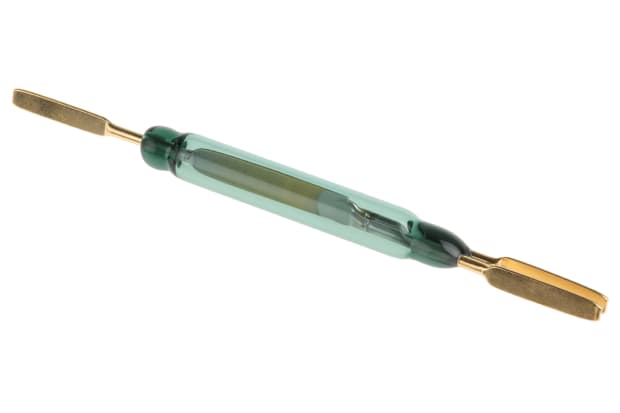
However, reed switches work differently. They are not usually touched at all during actuation. Instead, they rely on magnetic forces to move their contacts together or apart. Depending on the reed switch type you are using (normally open, normally closed or change over), proximity to a magnetic field either opens or closes a small air gap between the two metal blades. In the simplest models, this is often achieved by moving a reed switch magnet closer to - or further away from - the glass envelope housing the reeds.
The magnetic reed switch was invented in 1936 by Walter B. Elwood of Bell Laboratories. Modern versions rely on much the same basic principle as those produced under Elwood’s successful 1941 patent. Today, reed switches are found in a huge range of applications and devices - everything from laptops and mobile phones to key automotive systems, industrial machinery, and security sensors.
How Do Reed Switches Work?
Reed switches are a type of electrical switch actuated through magnetism. The actuation force can be generated either by introducing a permanent magnet or by a current being passed through an electromagnetic coil. The latter arrangement is key to reed relays.
A simple answer to the question ‘how does a reed switch work?’ is as follows:
Two individual wire contacts, known as the reeds, are housed in a hermetically sealed glass bubble or envelope. These serve as the switch contacts. This bubble is often filled with an inert gas like nitrogen to help prevent particle build-up causing performance issues over time. Depending on the installation environment, the glass envelope may also be encased in plastic for added toughness.
The switch reeds are ferromagnetic, meaning they are made from an iron-based metal that will respond quickly and easily to magnetic forces. This is typically an alloy of nickel and iron - usually 52% nickel. They will often be coated with an additional layer of tougher metal too, for longer working life. For some types of reed switches, only one of the wires is ferromagnetic, and the other will not move. Both reeds are blade-like, designed with a flattened and widened contact area. This offers greater reliability than single-point contacts.
The contacts are sputtered with a microscopically thin layer of iridium, rhodium or ruthenium, a coating which is applied on top of an under-layer made from tungsten, copper or gold. Low-resistivity silver may also be used, and some reed switches utilise mercury. This additional layer is included for optimum electrical contact. As the contacts are wetted, these switches must be held in specific orientations when mounted to prevent the liquid metal from dripping and bridging the contacts when not in use.
When a magnetic field is brought close enough to the outer casing of the reed switch, the contacts inside are pushed together or apart. This makes or breaks the circuit, depending on the direction of movement. In a normally open reed switch - the most common type - the two contact blades are positioned slightly apart, with an air gap between them. This leaves the circuit they are attached to incomplete until a magnetic force is introduced.
In a normally closed switch, the contacts are already touching when at rest. The introduction of a magnetic force instead pushes them apart, breaking the circuit. In either case, the spring force of one or more contact blades returns it to its natural position when not under magnetic pressure.
Lastly, change over switches have three reeds. They operate a break-before-make functionality, meaning that one contact will open its connection to another, before closing connection with the third.

Reed Switch Symbol
A typical example of a reed switch symbol on a circuit diagram will look something like the diagram to the right.
Whichever specific type is being used for a given device or task, these components are widely favoured for offering a versatile, clever and inexpensive solution to many common design issues.
Additional important notes to bear in mind when understanding how a reed switch works:
- Any switch in an electric circuit operates a bit like a moveable bridge, where the current flow is equivalent to traffic moving over the bridge. Open the switch, and no current flows; close it, and current can flow across it. Reed switches are no different in this sense
- When no magnet is present, the reed switch is stuck in whatever position it naturally defaults to and cannot be made to actuate in any other way. In other words, it is more or less a redundant device without the presence of an external magnetic field
- The type and size of the magnet needed to move the contact blades depend on several factors. These include the assembly, size, and sensitivity of the reed switch, as well as how close you can bring the external magnetic field to the switch housing
- One of the main benefits of reed switches is that you do not need to physically manipulate them, meaning they can be embedded and hidden within devices. This often results in magnetic forces having to travel a greater distance to actuate the reeds, so this will need to be considered when choosing a suitably powerful magnet
- Some magnet types are chosen because they are especially powerful (e.g. neodymium), while others produce an overall weaker magnetic field but with greater penetration depth (e.g. ferrite). Depending on switch location, this may also be a factor that influences your component choices
- The sensitivity of reed switches is typically measured in ampere-turns or AT, often somewhere in the region of 10-60 for most common uses. Lower numbers denote a more sensitive (more easily actuated) switch
- The general sensitivity of reed switches can be affected by various other factors, including position, distance, magnet orientation relative to the switch, and the polarity of the magnet itself. Often, a degree of experimentation is necessary to find the optimal arrangement of both components for the most reliable results
- It is also important to test for multiple actuations as a magnet passes by. This is common, especially in more sensitive switches where the influence of a magnetic field on the reeds changes constantly with small shifts in their relative positions. For many applications, imprecise magnet movement causing a switch to trigger on and off repeatedly would be problematic. Sensors linked to door-opening mechanisms or alarm systems are good examples
Reed Switch Applications
The reed switch is specifically designed to respond sensitively to the presence and absence of a magnetic field. This characteristic has led to its utilisation in myriad applications. Common uses include everything from reed switches for model railways through to core automotive systems and security devices.
Further everyday examples of reed switch uses might include:
- Laptops and mobile phones - reed switches are often used in clamshell designs and cases, allowing the device screen to power off when the lid is closed
- Automatic doors with proximity sensors, as well as things like lights connected to fridge doors
- Tamper-proofing systems like security alarms, functioning as proximity sensors and triggering when the magnet moves away from the switch on a window casing or doorjamb
- Measurement, flow rate and detection devices, such as anemometers to measure wind speed
- Auto shut-off devices, such as fluid level sensors and thermal cut-offs in dishwashers, washing machines and showers
- Safety features that prevent a device from powering on at all if, for example, a lid or guard is not correctly in place (e.g. food processors, power tools, etc)
- Automotive systems such as fluid gauges, automatic braking assists, door sensors and speedometers
Benefits of Reed Switches vs Other Switch Types
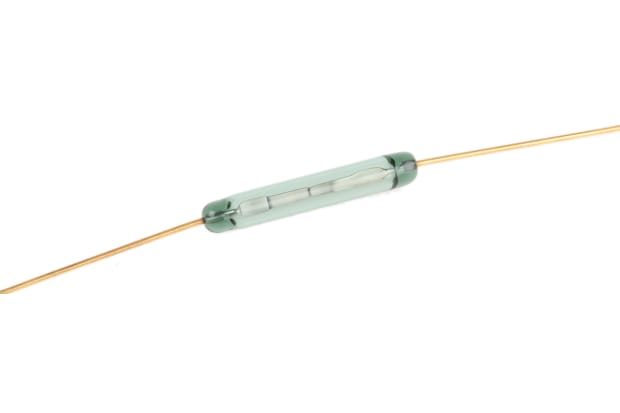
Some additional benefits of reed switches include:
- No need to physically access the switch to actuate it
- Lower power consumption than most other electronic switch types
- Reduced potential for electrical interference
- Easy to test out of the circuit, without having to be fully wired in first
- Reliable, durable, compact, and cheap (at least when designed for low-voltage applications, as the vast majority are)
- Highly customisable in terms of sensitivity and precision
- Very low mechanical wear resulting in long operational lifespan (typically in the millions, or even billions, of actuations)
- Suitability for use in many hazardous environments. The hermetically sealed nature of reed switches means they won’t corrode and pose no risk from sparking on actuation
Reed Switch Types
When shopping for reed switches and accessories online, you will find a wide range of designs and configurations on offer. Many are sold for use in specific applications and scenarios. You should note that simple reed switches are passive components; they do not demand continuous power to function.
Certain specialist types, such as hall-effect switches designed to trigger in continuous sensing roles (e.g. proximity sensors or speed detectors), must be mounted to circuits containing various other components and devices to perform as intended. Many such switching assemblies will require a constant flow of electrical current to work properly.
Examples of popular reed switch types you might see for sale online include:
- Arduino reed switches (modules, counters, speedometers, relays)
- Waterproof reed switch
- Electric reed switch
- NC reed switch
- Magnetic reed switches
- Plastic reed switch
- High current reed switch
- Encapsulated reed switch
- Cylindrical reed switch
- Bistable reed switch
- Latching reed switch
- Changeover reed switch
- Hamlin reed switch
- Hall-effect sensor
- Mini reed switch
- Micro reed switch
Normally Open and Normally Closed Reed Switches
All of the above variants are examples of reed switches intended for specific use cases. You can also choose from a wide range of reed switch sizes, configurations and materials. However, all switches of this type fall broadly into one of two basic categories - normally open, and normally closed.
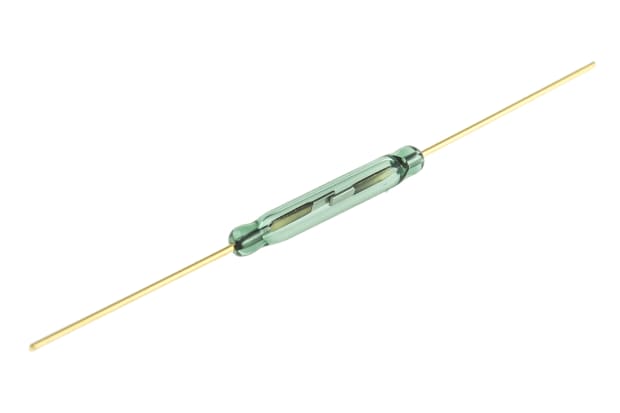
Normally Open Reed Switch (NO)
This is the most common type. NO reed switches are off in their resting position, with an air gap between the blades (hence open). Introduction of a magnet polarises the two reeds, pushing the contacts together and completing a circuit. Thus, current is allowed to flow across the switch. When the magnetic field is moved far enough away again, the contacts return to their apart position through the natural spring force created by their flexibility.
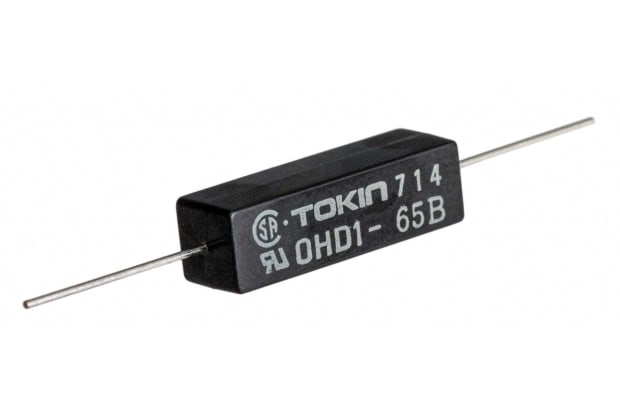
Normally Closed Reed Switch (NC)
An NC reed switch works the other way. The reeds are already in contact in their natural position, providing a closed circuit and allowing current to flow across the switch when no magnet is present. Introduction of a magnetic field with reversed polarity pushes the contacts apart, breaking the circuit.
Note that you can create an NC switch from an NO switch by simply leaving a magnet permanently affixed to the switch casing. In this example, a second magnet with (stronger) opposing polarity would need to be introduced to override the effect of the first.
What is a Reed Relay?
A reed relay circuit is an electrical switching assembly that uses an electromagnet to control one or more reed switches. Where simple reed switches often use permanent magnets, the magnetic field in a reed relay switch is generated on demand by pushing current through a coil surrounding the switch.
Reed relays are often used in setups that require the actuation of multiple switches simultaneously (or in sequence). They once formed the backbone of the telephone exchange system but are now more commonly seen in automatic testing and electronic instrumentation devices.
They can also be built to withstand increased voltages over most standard individual reed switches - up to several kilovolts. For this reason, reed relay circuits are still used as high-voltage relays in some higher-power switching applications.
Reed Switch Life Expectancy
Reed switch life expectancy is typically very good compared to most other switch types. Fatigue of the materials themselves is seldom an issue. The relatively tiny range of mechanical motion the contacts are subject to is far below the inherent fatigue limits of the metals they are made from.
The main factor influencing overall reed switch lifespan will be operating voltage. The majority of reed switches are designed for fairly low currents (almost always under 250V, unless explicitly designed otherwise). Versions built to support higher electrical loads on a single switch can be bought, but they tend to be considerably more expensive.
Other factors that can impact on overall longevity or long-term reliability of a reed switch might include:
- Contact arcing (usually through electrical discharge)
- AC vs DC loads
- Environmental factors - reed switches are vulnerable to vibration and shock
- Interference from other magnetic fields
